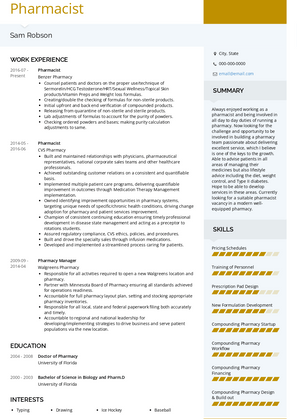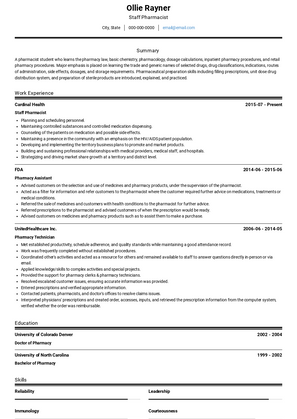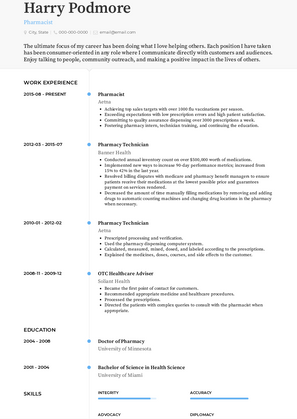Pharmacist Resume Examples [+ 3 Examples]
This page provides you with Pharmacist resume samples to use to create your own resume with our easy-to-use resume builder. Below you'll find our how-to section that will guide you through each section of a Pharmacist resume.



Pharmacist Resume Examples Overview
Despite spending copious amounts of money and time on attaining your pharmaceutical degree, it’s your pharmacist resume that will most likely determine your future career path. By spending some time crafting the perfect resume you can separate yourself from your competitors.
Our professionally designed pharmacist resume samples have helped over 3 million professionals, so now is the time to be inspired through these real life examples and start creating your dream career.
What is a Pharmacist?
A pharmacist is a healthcare professional who can work in many different aspects of healthcare. You’ve probably used the services of a pharmacist when buying over-the-counter medication, receiving a flu vaccine, or collecting a prescription. Pharmacists go through many years of specialized training so that they can offer a wide range of services, from dispensing medications to advising patients about their health to administering vaccinations.
If you’re interested in the medical profession, but aren’t sure you’d like to be a doctor, becoming a pharmacist may be a great option for your career. Pharmacists are highly respected, well-paid individuals who get to help others every day.
How do I write a resume for a Pharmacist?
To write a Pharmacist resume, follow these steps:
- Select a professional looking Pharmacist resume template that follows a reverse chronological layout.
- Make sure to shape your Pharmacist resume based on whether you are applying for retail pharmacy or non-retail pharmacy jobs.
- While writing your resume summary and work experience section try to quantify and show how much time you saved for the company or how much revenue was generated as a result of it.
The Best Format for a Pharmacist Resume
Writing your pharmacist resume in a reverse-chronological format is ideal when looking to show off your skills, experience and accomplishments.
Be sure to use big headings, clear and neat typeface and plenty of white space when constructing your resume. Export your Pharmacist resume in PDF rather than Microsoft word - the result will be a professional and intact product to deliver to recruiters.
3 Pharmacist Resume Summary Examples
Consider this at your elevator pitch, your potential hook to recruiters that will put you leagues in front of your competition. Use this as a summary if you’re an experienced pharmacist with years of prescription dispensing and logging, making your best skills and achievements stand out.
Many recruiters and companies now use Applicant Tracking Systems to automate and streamline the recruitment process. While this is a great benefit for companies, some applicants have been met with the frustration of their resumes not ever being seen by a real person -- if the resume doesn’t get past the ATS software, it’s usually discarded. Thankfully, VisualCV’s resume templates have been specifically designed to beat applicant tracking systems, making your pharmacist resume much more likely to make it in front of the right person.
The Wrong Way to Write a Pharmacist Resume Summary
Your summary shouldn’t be too wordy or personal – that’s what your cover letter is for! This first step in your pharmacist resume exists to give hiring managers a brief glimpse into your personality and experience. Not all hiring managers agree that a resume summary is necessary, but if your resume summary is clear, to the point, and hones in on what the job description is asking for, include it!
DON’T Do This
- Professional pharmacist with lots of experience providing health cover to people. Worked in a manager’s role for the past 3 years, overseeing colleagues.
Pharmacist Resume Summary Sample
Highly experienced and driven retail pharmacist with 10+ years of providing healthcare services to the local community. Have increased revenue for CVS by 15% per quarter for the past 5 years. Looking to leverage managerial skills in national, multi-venue role.
Professional Summary for a Pharmacist
Nuclear pharmacist with 3 years of caring for extremely vulnerable populations in hospital oncology ward. Have built a comfortable rapport with patients and healthcare workers. Looking to use my extensive pharmaceutical knowledge to continue providing a high level of care to a larger population.
Pharmacist Resume Summary Example
Hospital pharmacist with 5 years of experience working collaboratively with doctors to recommend best course of action regarding in-patient hospitalized children. Looking to use my knowledge and experience, along with my strong interpersonal skills, to expand into a managerial role.
How to Describe Your Experience on Your Pharmacist Resume
This is where you can really start bragging. Alison Green, author of Ask a Manager, highlights the single biggest resume mistake she saw in her time as a hiring manager: “Writing a resume that reads like a series of job descriptions.”
“The bullet points they use to describe what they did for each job just list activities and read like a job description for the role might,” she says. “For example, ‘edit documents,’ ‘collect data,’ or ‘manage website.’”
Have you got experience improving pharmacy automation and in turn reducing medication errors? Have you increased customer retention by significant numbers by improving pharmacy efficiency? Now is the time to make this known to recruiters.
A great work experience section is as follows:
Pharmacist | Terry White | 2008-present
- Managed 5 in-house pharmacy assistants, stockpiling and administering varying medicines to client roster and improving performance by 20%
- Improved pharmacy automation by 15% annually over the last 5 years, reducing medical errors significantly in the process
- Improved customer retention by 10% quarterly through delivering high-end, personalised customer service
A Bad Pharmacist Job Description on a Resume
Consider the following entries.
Pharmacist | Terry White | 2008-present
- Responsible for delivering medicines to clients
- Managed in-house assistants on daily tasks
- Maintained records
Junior Pharmacist | Central District Hospital, NY | 2014-present
- Daily clinical rotations
- Helped interpret lab charts
These entries focus on responsibilities you had at a previous job, but don't describe what you achieved there. Hiring managers will likely already understand the types of tasks you performed at previous jobs. Your goal is to show them how good you are at performing those tasks!
If you require more tips on writing about your work experience, check out our detailed resume guide.
How to List Skills on Your Pharmacist Resume
What skills should you include on a Pharmacist resume? While you should always try and list the skills that the job posting is asking for, there are some skills that come with the territory of being a pharmacist. Looking for more information about adding skills to your resume? Check out our resume skills examples.
Top Pharmacist Resume Skills in Demand in 2022
| Hard Skills for Pharmacists | Soft Skills for Pharmacists |
|---|---|
| Coumadin Administration | Discretion |
| Controlled Drug Administration | Strong Work Ethic |
| Prescription Accuracy Checks | Management |
| Prescription Dose Calculations | Active Listening |
| Liasing with Insurers to Clarify Coverage | Strong Communication |
| Resolving Billing Discrepancies | Customer Service |
| Securing Inventory of Drugs | Conflict Management |
| MTM Certification | Organization |
Most Important Soft Skills for Pharmacists
Communication
Communication is an important soft skill for many careers, but it’s absolutely essential for pharmacists. If a pharmacist is unable to communicate the exact required instructions for medication, it could cause serious harm to patients. You should be able to communicate with healthcare professionals as well as patients in order to be the best possible pharmacist you can be.
Compassion
Pharmacists inherently deal with sick or disabled people who are looking for relief of pain and other unpleasant symptoms. You’ll need to be compassionate to best work with your patients and make sure they have the most positive experience possible, whether they’re seriously ill or a young child nervous about receiving a vaccine.
Detail-Oriented
Do you have a keen eye for detail? You’ll need one to be a pharmacist! Precision is crucial for success as a pharmacist – you’ll need to count out exact numbers of pills or measure exact dosages. You’ll also often need to read instructions from other healthcare professionals to know what types of medications you’ll be preparing for patients. The stakes are high when you work as a pharmacist: your patients could be unnecessarily in pain, or experience an allergic reaction, if you don’t notice every little detail about their situation.
Related Resumes
Something about this job catch your eye, but you aren’t quite sure if it’s a match? Check out these related resumes and discover where your next career move could take you.
Should a Pharmacist use a CV or resume?
Ideally, a Pharmacist should use a resume as it is shorter and gives out relevant information to a hiring manager with ease. CVs originally are expected to be lengthier with a lot more detail than required making it harder to be used for non-academic purposes.
What should a Pharmacist put on a resume?
All Pharmacist resumes should have the following on it: time saved and revenue generated, relevant job experience (specific to retail or non-retail pharmacy roles).
How do you write Pharmacist experience on a resume?
List your experience under the work experience section. List your Pharmacist duties in a bullet list under your Pharmacist role. Make sure to highlight the impact you made in that role.
How many pages should a Pharmacist resume be?
A Pharmacist resume should ideally be one page. Two pages are acceptable for a Pharmacist resume with more than 15 years of experience.
Pharmacist Salaries
Because of the great deal of training and experience required to become a pharmacist, the pharmacy career has a reputation for providing people with high salaries. In the US, the average base salary for a pharmacist is $120,000, according to Indeed. Entry-level positions start at an average of $107,000, and pharmacists with more than 10 years of experience could make $133,000 and above per year.
Keep in mind that, depending on the cost of living in your state or region, salaries may fluctuate. If you live in a city with a very high cost of living, for example, your salary may be much higher, but your day-to-day expenses will also be more expensive.
How to Become a Pharmacist
To become a pharmacist in the US, you’ll have to first earn a Doctor of Pharmacy (or PharmD) degree from an accredited pharmacy institution. Once you’ve obtained your PharmD degree, you’ll need to pass a state exam that will lead to you becoming a licensed pharmacist. While this seems like a lot of work for some, for the dedicated pharmacy professionals interested in this career path, it’s an exciting challenge and opportunity to learn.
What Should You Study to Become a Pharmacist?
Before you can enroll in a PharmD program – the degree you must have in order to become a pharmacist in the US – you must complete undergraduate study. If you’re seeking a fast-track PharmD program, it may be possible for you to transfer into the program after two completed years of undergraduate education. Otherwise, you’ll have to complete a full undergraduate degree. Check requirements for PharmD programs near you to determine which types of classes you should take as an undergraduate student. PharmD programs will expect for you to have college education in:
- Biology
- General and organic chemistry
- Physics
- Math
- Statistics
- English
- History
- Economics
Many students opt to major in science in order to obtain the high number of science credits required for a PharmD program, but, technically, a pre-pharmacy student can major in anything they wish.
Following graduation from an undergraduate program, hopeful pharmacists will take the PCAT (Pharmacy College Admission Test), a standardized test that all prospective students must pass before continuing to their PharmD program. PharmD programs take 3-4 years to complete, and, if you’re interested in working in a clinical pharmacy or in pharmaceutical research, you’ll then have to complete a one- to two-year residency program.
Regardless of what area of pharmacy you specialise in, showcasing a PharmD and its associated training and placements is absolutely necessary. What is also integral, however, is that you highlight key skills and achievements that are personal to you.
Same goes for graduates, but probably more importantly - focusing on your education is what will land you that prized interview. You could even consider putting this information at the beginning of your resume if you so choose.
Most importantly, include these pieces of information in your education section:
- Where you’ve studied
- What you’ve studied
- When you studied
- Any certifications you’ve earned (Medication Therapy Management, Cardiovascular Disease Risk Management, Toxicology, Pharmacokinetics)
Ensure that what you are telling your prospective employer is completely truthful. If you’re a junior level pharmacist with limited practical experience, let recruiters know. You can use any transferable skills and indicate your drive to continue your professional practice.
PharmD | Monash University | 2005-2010
- Developed clinical operations through sponsored industry placement at central hospital
- Dux of Pharmacy Technology unit
- Co-organised charity events annually to find sponsors for critically ill children
Final Thoughts
Many people think about becoming pharmacists because of the high salaries, but there’s much more to the job than that. Beyond the years of expensive schooling and competitive work placements, working as a pharmacist can be simultaneously emotionally draining and emotionally rewarding. But if you’re excited about the prospect of a career in which you help care for your community and serve the greater goals of public health, you might just make a perfect pharmacist!
A professionally designed resume is one way to make your application stand out from the crowd. Whether you choose to use eye-catching color, a unique format, or simply a clean and polished template with your skills and achievements on display, a VisualCV Pro membership could be the thing that takes your career to the next level.
Copyright ©2025 Workstory Inc.
